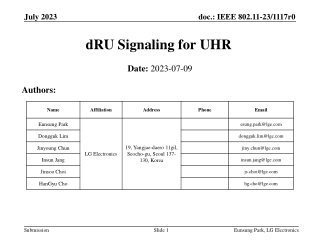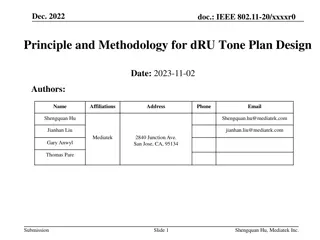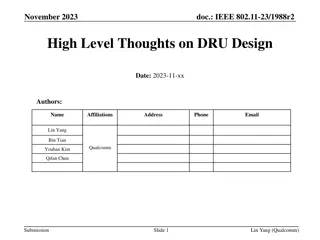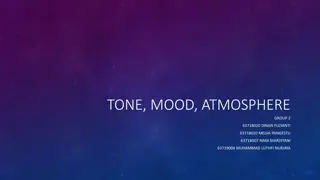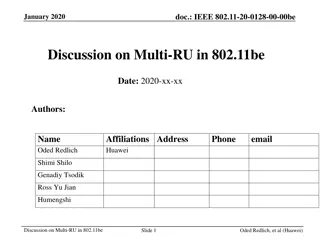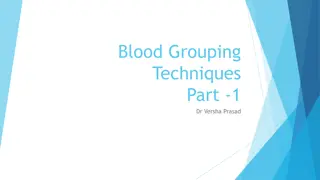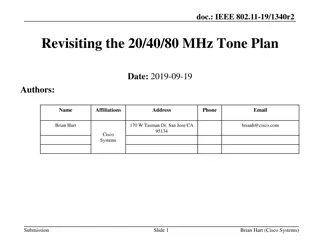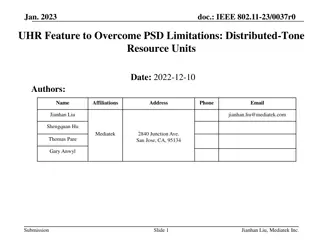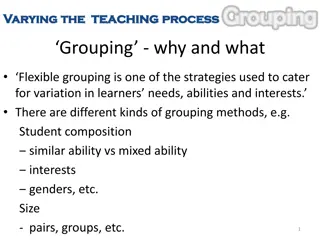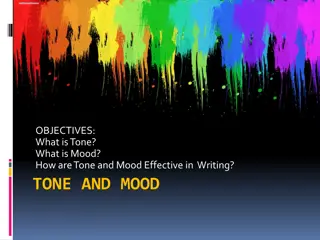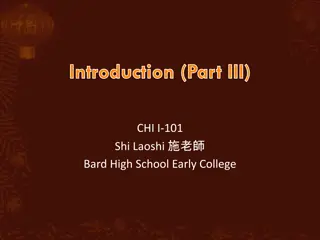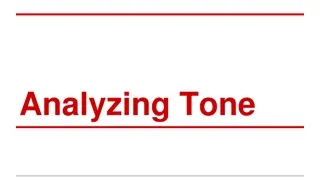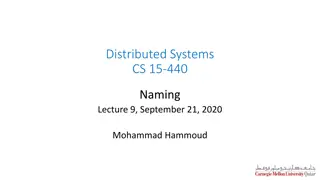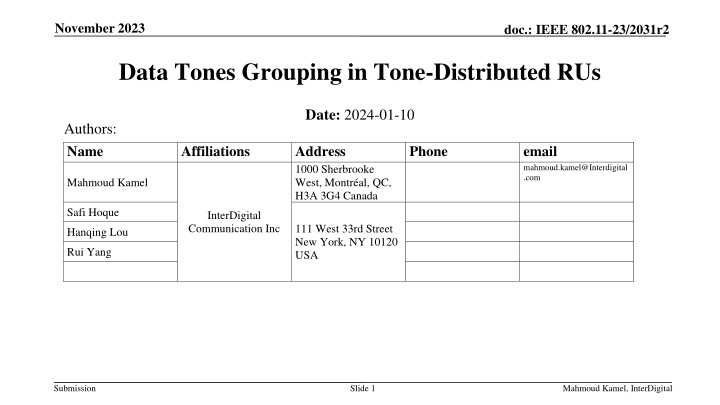
Improving Wireless Network Performance Through Data Tones Grouping
Explore the benefits of data tones grouping in Tone-Distributed Resource Units (dRUs) for enhancing Packet Error Rate (PER) performance in IEEE 802.11 networks. Discover different methods of grouping data tones and how this optimization can impact channel bandwidth and signal quality. Learn how pilot tones are strategically positioned to aid in phase estimation and noise filtering, particularly in low Signal-to-Noise Ratio (SNR) scenarios.
Download Presentation

Please find below an Image/Link to download the presentation.
The content on the website is provided AS IS for your information and personal use only. It may not be sold, licensed, or shared on other websites without obtaining consent from the author. If you encounter any issues during the download, it is possible that the publisher has removed the file from their server.
You are allowed to download the files provided on this website for personal or commercial use, subject to the condition that they are used lawfully. All files are the property of their respective owners.
The content on the website is provided AS IS for your information and personal use only. It may not be sold, licensed, or shared on other websites without obtaining consent from the author.
E N D
Presentation Transcript
November 2023 doc.: IEEE 802.11-23/2031r2 Data Tones Grouping in Tone-Distributed RUs Date: 2024-01-10 Authors: Name Affiliations Address 1000 Sherbrooke West, Montr al, QC, H3A 3G4 Canada Phone email mahmoud.kamel@Interdigital .com Mahmoud Kamel Safi Hoque InterDigital Communication Inc 111 West 33rd Street New York, NY 10120 USA Hanqing Lou Rui Yang Submission Slide 1 Mahmoud Kamel, InterDigital
November 2023 doc.: IEEE 802.11-23/2031r2 Abstract In this contribution, we follow up on the discussion of grouping of the data tones in Tone-Distributed RUs (dRUs) and show the PER performance of data tones grouping. Submission Slide 2 Mahmoud Kamel, InterDigital
November 2023 doc.: IEEE 802.11-23/2031r2 Background Tone-Distributed Resource Unit (dRU) is proposed in [1] as a solution for long range In [2], pilot design and CFO impact have been discussed and the authors have shown how the choice of the pilot tones can significantly impact the performance for different CFO which is further extended in [4] The authors of [3] proposed reusing the RU allocation indication of rRUs for dRUs In [5], the authors discussed further considerations for dRUs including channel widths for dRU transmissions, dRU transmission given preamble puncturing, and dRUs sizes allowed in each channel width In [6], the authors have shown the impact of pilot tone allocation on the performance of dRUs and have discussed other considerations, including the grouping of data tones in dRUs. In [7], the authors proposed a use case for using dRUs in the downlink Submission Slide 3 Mahmoud Kamel, InterDigital
November 2023 doc.: IEEE 802.11-23/2031r2 Grouping of Data Tones The tones of a 26-tone dRU in 20 MHz channel may be selected in different ways: Method 1: One tone out of each 9 tones is allocated to each dRU in turn [2] (See Slide 7). Method 2: Two or more consecutive tones are allocated to each dRU in turn uniformly. Example: a 26-tone dRU has 24 data tones and 2 pilot tones, the 24 data tones may be grouped in different ways: 2 12 12 groups each of 2 data tones 3 8 8 groups each of 3 data tones 4 6 6 groups each of 4 data tones Submission Slide 4 Mahmoud Kamel, InterDigital
November 2023 doc.: IEEE 802.11-23/2031r2 Grouping of Data Tones The groups of data tones can be symmetrically located across the channel bandwidth The pilot tones are positioned in the middle of two of the data groups (in case of 26-tone dRUs) Data tones Pilot tones The group of data tones including the pilot tone can be used to improve the phase estimation by filtering out the noise, especially in low SNR scenarios This can start from the LTF symbol(s) and can be carried forward to the data symbols The group of data tones can further be used to enhance the channel estimation through simple channel smoothing Submission Slide 5 Mahmoud Kamel, InterDigital
November 2023 doc.: IEEE 802.11-23/2031r2 Grouping of Data Tones Full Picture Submission Slide 6 Mahmoud Kamel, InterDigital
November 2023 doc.: IEEE 802.11-23/2031r2 Ungrouped Data Tones Submission Slide 7 Mahmoud Kamel, InterDigital
November 2023 doc.: IEEE 802.11-23/2031r2 LTF-Assisted Phase Tracking The group of data tones including the pilot tone can be used to implement an improved phase tracking algorithm by averaging over the channel response in the LTF symbol Recall that in rRUs this can be done since all the tones of the RU are next to each other ??????=????? 1 + ????? + ???? ? + 1 3 The improved channel response of the pilot tones improves the phase tracking performance. In dRUs, a tone plan that would enable this improved phase tracking is desirable This is easily achievable by grouping the data tones Submission Slide 8 Mahmoud Kamel, InterDigital
November 2023 doc.: IEEE 802.11-23/2031r2 Channel Smoothing The group of data tones can also be used to improve the channel estimation through simple channel smoothing ????(?) =? ? 1 ????? 1 + ? ? ????? + ? ? + 1 ???? ? + 1 ? ? 1 + ? ? + ?(? + 1) ?, ?, 0, ? = ? ??? ? ???? ? = ? 1 ?? ? = ? + 1??? ? ???? ? ? = ? ???? ? and ? are the weights of the smoothing filter. ????is the set of subcarrier indices belong to a given dRU Submission Slide 9 Mahmoud Kamel, InterDigital
November 2023 doc.: IEEE 802.11-23/2031r2 Considerations of Grouping of Data Tones Several considerations for data tones grouping of dRUs Simplicity: Larger dRUs may be simply comprised of smaller dRUs Performance: Some tone plans may have a better PER performance than others Maximum Power Boost: A tradeoff between the maximum power boost and the mitigation of CFO may be considered Diversity vs Phase Tracking: Grouping of data tones enables LTF- assisted phase tracking which in turn improves the performance, but may also impact the gain of frequency diversity in dRUs NOTE: the notation 26dRU20 is referring to a 26-tone dRU distributed over a 20 MHz subchannel Power Boost Factor [dB] Group Size 1 8.13 2 6.37 3 5.12 26dRU20 Submission Slide 10 Mahmoud Kamel, InterDigital
November 2023 doc.: IEEE 802.11-23/2031r2 Simulation Environment Simulation Parameters Channel Bandwidth = 20 MHz (nine 26-tones dRUs) LDPC Coding , MCS = 0, MCS = 3 and MCS = 7 SISO with Channel Model D Residual CFO: [dRU1:+CFO, dRU2: -CFO, , dRU9: +CFO] CFO = 0 and 300 Hz are considered Phase tracking is always used SNR is defined as the average SNR per user. The dRUs are comprised using 2 12 grouping scheme (see Slide 6) Ungrouped dRUs tone plan is referring to Method 1 in Slide 4 Packet Size = 100 bytes Pilot Positions: in the middle of the 4th and the 9th data tones groups Channel smoothing weights a = 2 and b = 1 The PER for the first dRU is considered Submission Slide 11 Mahmoud Kamel, InterDigital
November 2023 doc.: IEEE 802.11-23/2031r2 MCS 0 in Channel D Grouping of data tones yields a nice PER performance improvement if LTF-assisted phase tracking is applied (red curves). Further PER performance improvement is also achievable if channel smoothing is applied (green curves) . No loss in the performance of data tones grouping if conventional phase tracking is applied (blue curves). The performance is no worse than the ungrouped data tones (black curves). Submission Slide 12 Mahmoud Kamel, InterDigital
November 2023 doc.: IEEE 802.11-23/2031r2 MCS 3 in Channel D Similar performance is achievable for MCS = 3. Submission Slide 13 Mahmoud Kamel, InterDigital
November 2023 doc.: IEEE 802.11-23/2031r2 MCS 7 in Channel D In higher MCSs, the performance of grouped tones is consistently better than that of the ungrouped tones for larger CFOs. Submission Slide 14 Mahmoud Kamel, InterDigital
November 2023 doc.: IEEE 802.11-23/2031r2 Conclusions and Way Forward Grouping of data tones brings improvements to the phase tracking performance and the channel estimation through channel smoothing which in turn improves the PER performance, especially in low SNR scenarios Recall that dRUs are proposed to support long range applications where low SNR are more probable. Close to 1.5 dB of improvement in the PER performance is achievable (compared to the ungrouped tones). A tradeoff may be considered between improving the PER performance gain through better phase tracking and channel smoothing versus the loss due to less diversity. Other techniques may be considered to bring further improvements to the PER performance of the Tone-Distributed RUs (dRUs). Slide 15 Submission Mahmoud Kamel, InterDigital
November 2023 doc.: IEEE 802.11-23/2031r2 SP1 Do you support grouping of the data tones of dRUs to allow for channel smoothing and improved phase tracking 1) Yes 2) No 3) Abs This SP is for information gathering only Submission Slide 16 Mahmoud Kamel, InterDigital
November 2023 doc.: IEEE 802.11-23/2031r2 References [1] 11-23/0037r0, UHR Feature to Overcome PSD Limitations Distributed-Tone Resource Units [2] 11-23/1115r0, CFO Impact and Pilot Design for dRU [3] 11-23/1117r0, dRU Signaling for UHR [4] 11-23/1447r0, CFO Impact and Pilot Design for dRU Follow up [5] 11-23/1448r0, Further Considerations on dRU [6] 11-23/1511r1, Pilot Tone Allocation and Other Considerations of Tone-Distributed RUs for UHR [7] 11-23/1516r0, Use case for distributed RUs in Downlink Submission Slide 17 Mahmoud Kamel, InterDigital
November 2023 doc.: IEEE 802.11-23/2031r2 Backup LTF-assisted Phase Tracking The channel estimate of the pilot tones from an LTF symbol with ?ppilot tones can be expressed by LTFT L??, 2 LTF , ?? LTF= 1 ?p The reference pilot symbols (x?? { 1,+1}) of the received ?s OFDM symbols can be expressed by the matrix ?p ?11 ???,1 ref of size ?p ?s where: ?1,?? ??p,?s ref= xp exp of The expected channel response for the pilot tones of all OFDM symbols can be expressed by ?p size ?p ?s where ?p exp= ?p LTF ?p LTF ?p LTF Submission Slide 18 Mahmoud Kamel, InterDigital
November 2023 doc.: IEEE 802.11-23/2031r2 Backup LTF-assisted Phase Tracking The received pilot tones of the ?s OFDM symbols can be expressed by the matrix ???? of size ?p ?s ?11 ???,1 ?1, ?? ???,?? ????= The expected pilot tones can be expressed as exp= ?p exp ?p ref ?p where, is the element wise product The LTF-assisted pilot estimates of the ?s OFDM symbols can be then expressed as 1 ltf?11 ?p ltf?1,?s ?p ?11 ?1,?s 1 exp ?prx = Y = ?p ltf??p,1 ltf??p?s ??p,1 ??p?s Submission Slide 19 Mahmoud Kamel, InterDigital
November 2023 doc.: IEEE 802.11-23/2031r2 Backup LTF-assisted Phase Tracking The CPE ?? of the OFDM symbol ? {?,?, ,??} can be estimated by summing each column of the Y matrix and computing the phase of each summed column ?=?? ltf??? ? ??= ??? ?=? Submission Slide 20 Mahmoud Kamel, InterDigital

